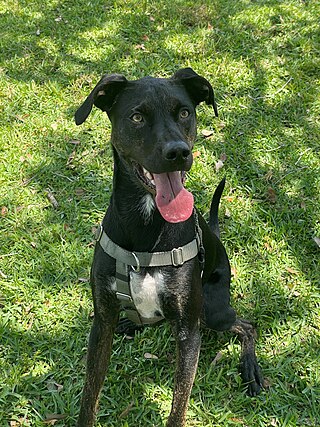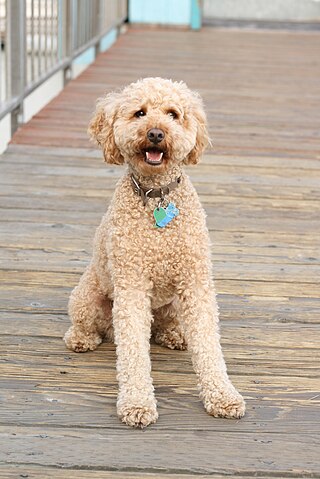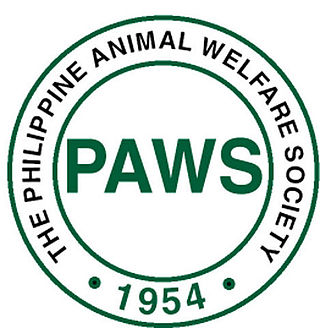
The EnglishGreyhound, or simply the Greyhound, is a breed of dog, a sighthound which has been bred for coursing, greyhound racing and hunting. Since the rise in large-scale adoption of retired racing Greyhounds, the breed has seen a resurgence in popularity as a family pet.

Pet adoption is the process of transferring responsibility for a pet that was previously owned by another party. Common sources for adoptable pets are animal shelters, rescue groups, or other pet owners. Some organizations give adopters ownership of the pet, while others use a guardianship model wherein the organization retains some control over the animal's future use or care.

An animal shelter or pound is a place where stray, lost, abandoned or surrendered animals – mostly dogs and cats – are housed. The word "pound" has its origins in the animal pounds of agricultural communities, where stray livestock would be penned or impounded until they were claimed by their owners.

The Miniature Schnauzer is a breed of small dog of the Schnauzer type that originated in Germany in the mid-to-late 19th century. Miniature Schnauzers may have been developed from the smallest specimens of the Standard Schnauzer, or crosses between the standard and one or more smaller breeds such as the Affenpinscher, Miniature Pinscher, and Poodles, as farmers bred a small dog that was an efficient ratting dog. They are described as "spunky" but aloof dogs, with good guarding tendencies without some guard dogs' predisposition to bite. Miniature Schnauzers are recognized in four colors internationally: solid black, black and silver, salt and pepper, and white.

The Goldendoodle is a designer dog created by crossbreeding a Golden Retriever and a Poodle. First widely bred in the 1990s, they are bred in three different sizes—each corresponding to the size of Poodle used as a parent.

The Poodle, called the Pudel in German and the Caniche in French, is a breed of water dog. The breed is divided into four varieties based on size, the Standard Poodle, Medium Poodle, Miniature Poodle and Toy Poodle, although the Medium Poodle is not universally recognised. They have a distinctive thick, curly coat that comes in many colors and patterns, with only solid colors recognized by breed registries. Poodles are active and intelligent, and are particularly able to learn from humans. Poodles tend to live 10–18 years, with smaller varieties tending to live longer than larger ones.

A mongrel, mutt, or mixed-breed dog is a dog that does not belong to one officially recognized breed, including those that result from intentional breeding. Although the term mixed-breed dog is sometimes preferred, many mongrels have no known purebred ancestors.

The soft-coated Wheaten Terrier is a pure-breed terrier originating from Ireland. Wheatens typically have one of two coat types: Irish or Heavy (American). The Irish coat is generally silkier and wavier than the Heavy, or American coat, which is thicker and fuller. Wheatens are generally friendly and playful, and tend to get along well with children and other dogs.

The Bedlington Terrier is a breed of small dog named after the mining town of Bedlington, Northumberland in North East England. Originally bred to hunt, the Bedlington Terrier has since been used in dog racing, numerous dog sports, as well as in conformation shows and as a companion dog. It is closely related to the Dandie Dinmont Terrier, Whippet and Otterhound.

The Portuguese Water Dog originated from the Algarve region of Portugal. From there the breed expanded to all around Portugal's coast, where they were taught to herd fish into fishermen's nets, retrieve lost tackle or broken nets, and act as couriers from ship to ship, or ship to shore. Portuguese Water Dogs rode in fishing trawlers as they worked their way from the Atlantic waters of Portugal to the waters off the coast of Iceland fishing for cod.

The French Bulldog is a French breed of companion dog or toy dog. It appeared in Paris in the mid-nineteenth century, apparently the result of cross-breeding of Toy Bulldogs imported from England and local Parisian ratters. It is commonly kept as a pet, and is among the most frequently registered dogs in a number of countries including Australia, the United Kingdom, and the United States. The breed is susceptible to various health issues as a consequence of breeding for their distinctive appearance, especially the brachycephalic face and skin wrinkles.

A black cat is a domestic cat with black fur that may be a specific breed, or a common domestic cat of no particular or mixed breed. All-black fur pigmentation is slightly more prevalent in male cats than female cats. Most black cats have golden irises due to their high melanin pigment content. Black cats are the subject of myth, legend, and superstition. They are often associated with witches and bad luck in European folklore.

Dog crossbreeds, sometimes called designer dogs, are dogs which have been intentionally bred from two or more recognized dog breeds. They are not dogs with no purebred ancestors, but are not otherwise recognised as breeds in their own right, and do not necessarily breed true.

The coat of the domestic dog refers to the hair that covers its body. Dogs demonstrate a wide range of coat colors, patterns, textures, and lengths.
An animal rescue group or animal rescue organization is a group dedicated to pet adoption. These groups take unwanted, abandoned, abused, or stray pets and attempt to find suitable homes for them. Many rescue groups are created by and run by volunteers, who take animals into their homes and care for them—including training, playing, handling medical issues, and solving behavior problems—until a suitable permanent home can be found.
In some countries there is an overpopulation of pets such as cats, dogs, and exotic animals. In the United States, six to eight million animals are brought to shelters each year, of which an estimated three to four million are subsequently euthanized, including 2.7 million considered healthy and adoptable. Euthanasia numbers have declined since the 1970s, when U.S. shelters euthanized an estimated 12 to 20 million animals. Most humane societies, animal shelters and rescue groups urge animal caregivers to have their animals spayed or neutered to prevent the births of unwanted and accidental litters that could contribute to this dynamic.

The potcake dog is a mixed-breed dog type found on several Caribbean islands. Its name comes from a traditional local dish of seasoned rice and pigeon peas; overcooked rice that sticks to the bottom of the cooking pot is commonly mixed with other leftovers and fed to the dogs. Although appearance varies, potcakes generally have smooth coats, cocked ears, and long faces.

The Philippine Animal Welfare Society (PAWS) is a volunteer-based, non-government organization whose goal is to prevent animal cruelty through education, animal sheltering and advocacy, based in Quezon City, Philippines. It was founded in 1954 by Muriel Jay. PAWS believes that the creation of a more peaceful society starts with the widening of mankind's circle of compassion which includes animals, thereby envisions a nation that respects animals, practices responsible pet ownership and protects wildlife. The volunteer-based organization rehabilitates these animals in the hope of finding them new homes and a second chance at a good life. PAWS does not take in pets of other people, but only victims of cruelty or neglect where the animal offenders are charged with violation of the Animal Welfare Act in court.

The Pug is a breed of dog with the physically distinctive features of a wrinkly, short-muzzled face, and curled tail. An ancient breed, with roots dating back to 400 B.C., they have a fine, glossy coat that comes in a variety of colors, most often fawn or black, and a compact, square body with well developed and thick muscles all over the body.

















